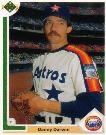
|
This Could Be Your Ad! Sponsor . . .
Singleton vs. Rice! Advertise your business, or pay tribute to your favorite team! |

|
This Could Be Your Ad! Sponsor . . .
Singleton vs. Rice! Advertise your business, or pay tribute to your favorite team! |
Honestly, I really don't want to defend Ken Singleton to Asher because the last thing his Top 200 list needs is another outfielder from the 1980's. But I feel myself being pulled into the argument by a force stronger than gravity.
Asher seems to think that because Singleton and Rice played in similar eras, that he can get away with just comparing their raw stats. Singleton did spend more time in the offensively-depressed 1970's and some time in the offensively-depressed National League. But the real kicker is their home ballparks. Asher and Scott both are blinded by the effects of Fenway Park, which is part of the reason why Scott has Dwight Evans too high and why they both have Carl Yastrzemski too high. Let's compare Singleton and Rice's road statistics (courtesy of retrosheet.org) in order to put the two on a more even keel:
| Player | G | AB | R | H | 2B | 3B | HR | RBI | BB | K | AVG | OBP | SLG |
| Singleton | 1042 | 3753 | 500 | 1081 | 165 | 15 | 129 | 544 | 598 | 630 | .288 | .384 | .443 |
| Rice | 1041 | 4150 | 568 | 1148 | 166 | 35 | 174 | 649 | 322 | 732 | .277 | .330 | .459 |
This is another good comparison since the two players have basically the same number of road games played. As you can see, Rice still beats Singleton in most of the counting stats that Asher mentioned. But there's a good reason for this: nearly 400 more at bats. This edge in at bats is explained mostly by Singleton's 276 lead in free passes and partly by Earl Weaver's penchant for platooning.
Anyway, I love on-base percentage, I really do. But you don't have to be Billy Beane to see that a fifty-four point difference in OBP is just a teensie bit more significant than a sixteen point variance in SLG. If you're wondering why Singleton's walks didn't lead to more runs scored, I've addressed that issue before. The fact remains that Singleton was a far more valuable hitter when you remove the Fenway Park bias. If you don't agree with that statement, then you should rank Hank Aaron ahead of Babe Ruth, because all you care about is counting stats.
Do you like the way that Asher slips in how Rice was a better fielder without stopping to defend it? That was a good try, but it did not escape my notice. Rice had many more outfield assists, but again, that's the Green Monster effect: he had many more opportunities because of all of the would-be doubles off of the wall. It is also worth noting that Ken Singleton notched 20 outfield assists in his first year in right field. After that, teams may have simply stopped running on him.
Both outfielders had a .980 fielding percentage, so there's not much to look at there. Singleton did have a lot more ground to cover, obviously. Rice wound up with more putouts, but again, teams stack right-handed lineups when they play at Fenway, creating more opportunities for Rice.
In the end, I still believe that Rice's inclusion has more to do with Asher's 1980's bias than anything else. The dig on Singleton and ignorance of Fenway Park effects is probably just Asher grasping at straws in order to justify this bias. After all, Singleton played just a bit earlier than Rice did. e might have been just before Asher's time. Maybe Asher didn't have as many neat-looking baseball cards of Singleton as he did Rice. Of course, as an eight year old, the backs of Rice's baseball cards would have looked much more impressive with all of those killer counting stats of his. Asher just hasn't updated his analysis in the past 20 years. Perfectly understandable.


 Tired of defensive stats that are misleading, arbitrary, and compicated?
Tired of defensive stats that are misleading, arbitrary, and compicated?Then pick up your copy of The Fielding Bible today for $7 off the cover price! Read Keith's Review to find out more. |